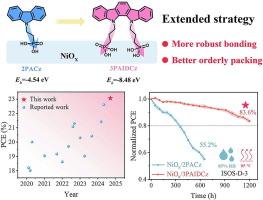为稳定的柔性钙钛矿太阳能电池设计热坚固的孔选择层
IF 13.2
1区 工程技术
Q1 ENGINEERING, CHEMICAL
引用次数: 0
摘要
基于自组装单层(SAM)的孔选择层(HSL)对柔性钙钛矿太阳能电池(fPSCs)的热稳定性起着决定性的作用。特别是,SAMs和衬底之间的结合对于增强fPSCs的热应力抵抗能力至关重要。在此,我们采用吲哚[2,3-a]咔唑-11,12-二基双(丙烷-3,1-二基))双膦酸(3PAIDCz) SAM,并在氧化镍(NiOx)薄膜上使用双磷酸盐锚定基团,形成可承受高温的热坚固HSL。与[2-(9h -卡巴唑-9-酰基)乙基]膦酸(2PACz)单磷酸锚定基团相比,二磷酸锚定基团使NiOx/SAM界面增韧,在热应力下的聚集性更小。此外,3PAIDCz与钙钛矿膜表现出出色的能带对准,减少了界面非辐射损失。因此,冠军fpsc实现了22.90 %的认证功率转换效率(PCE),这是基于双HSL的倒置fpsc的最高值之一。此外,根据iso - l - 2i协议,未封装的fPSCs在T80 >; 600 h(即85 °C和照明)的热和光应力下表现出突出的耐久性。根据iso - d -3协议,封装的fPSCs在标准湿热应力(即85 °C和85 % RH)下显示T80 >; 1200 h。本研究通过开发热稳健的HSL,有效地解决了fPSCs热稳定性的关键问题。本文章由计算机程序翻译,如有差异,请以英文原文为准。

Engineering a thermally robust hole-selective layer for stable flexible perovskite solar cells
Self-assembled monolayer (SAM) based hole-selective layer (HSL) plays a decisive role in the thermal stability of flexible perovskite solar cells (fPSCs). In particular, the binding between SAMs and the substrate is essential for enhancing the thermal stress resistance of fPSCs. Herein, we employ a indolo[2,3-a]carbazole-11,12-diylbis (propane-3,1-diyl)) bisphosphonic acid (3PAIDCz) SAM with a bisphosphate anchoring group on the nickel oxide (NiOx) film to form a thermally robust HSL for fPSCs that can withstand at a high temperature. The bisphosphate anchoring group toughens the NiOx/SAM interface and show less aggregation under thermal stress when compared with monophosphate anchoring groups of [2-(9H-Carbazol-9-yl) ethyl] phosphonic acid (2PACz). Additionally, 3PAIDCz exhibits outstanding band alignment with the perovskite film, reducing the interfacial non-radiative losses. As a result, the champion fPSCs achieve a certified power conversion efficiency (PCE) of 22.90 %, which is one of the highest values for dual HSL based inverted fPSCs. Moreover, the unencapsulated fPSCs exhibit prominent durability under thermal and light stresses with T80 > 600 h (i.e., 85 °C and illumination) following the ISOS-L-2I protocol. The encapsulated fPSCs show a T80 > 1200 h under standard damp-heat stress (i.e., 85 °C and 85 % RH) according to the ISOS-D-3 protocol. This research effectively addresses the key issue of thermal stability for fPSCs by developing a thermally robust HSL.
求助全文
通过发布文献求助,成功后即可免费获取论文全文。
去求助
来源期刊

Chemical Engineering Journal
工程技术-工程:化工
CiteScore
21.70
自引率
9.30%
发文量
6781
审稿时长
2.4 months
期刊介绍:
The Chemical Engineering Journal is an international research journal that invites contributions of original and novel fundamental research. It aims to provide an international platform for presenting original fundamental research, interpretative reviews, and discussions on new developments in chemical engineering. The journal welcomes papers that describe novel theory and its practical application, as well as those that demonstrate the transfer of techniques from other disciplines. It also welcomes reports on carefully conducted experimental work that is soundly interpreted. The main focus of the journal is on original and rigorous research results that have broad significance. The Catalysis section within the Chemical Engineering Journal focuses specifically on Experimental and Theoretical studies in the fields of heterogeneous catalysis, molecular catalysis, and biocatalysis. These studies have industrial impact on various sectors such as chemicals, energy, materials, foods, healthcare, and environmental protection.
 求助内容:
求助内容: 应助结果提醒方式:
应助结果提醒方式:


